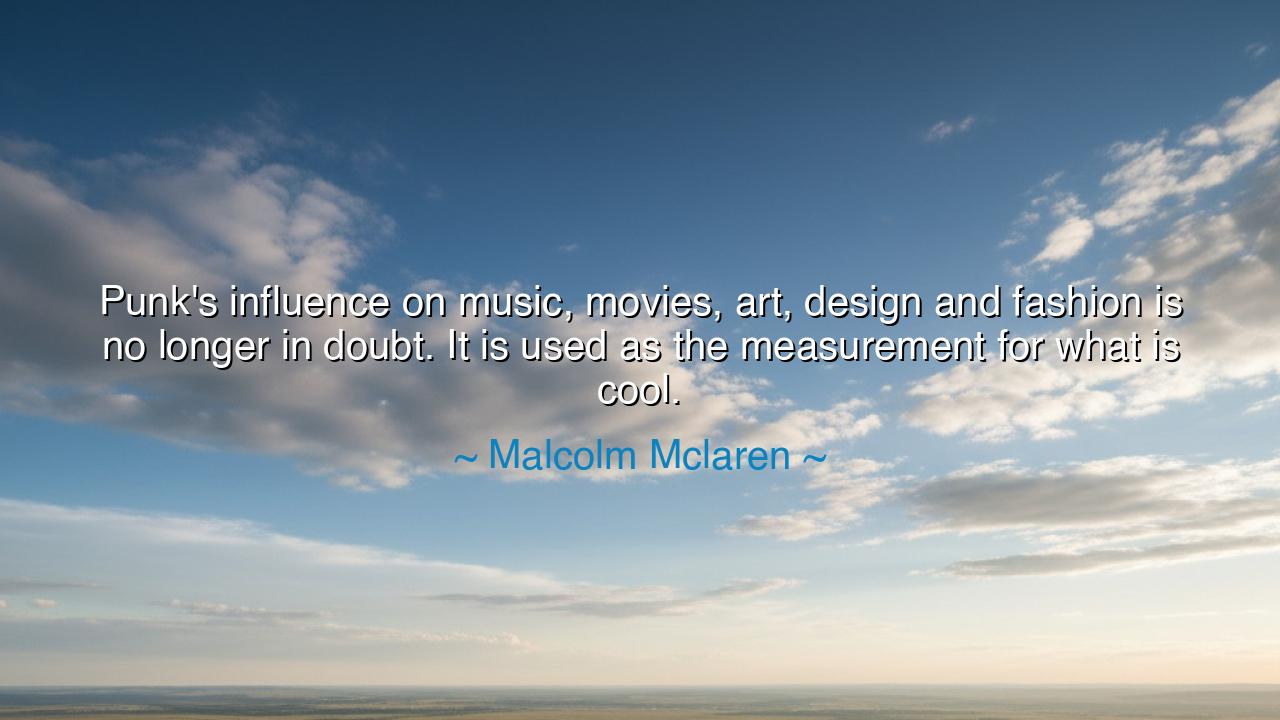
Punk's influence on music, movies, art, design and fashion is no
Punk's influence on music, movies, art, design and fashion is no longer in doubt. It is used as the measurement for what is cool.






The words of Malcolm McLaren—“Punk’s influence on music, movies, art, design and fashion is no longer in doubt. It is used as the measurement for what is cool.”—are a declaration not only of cultural triumph, but of rebellion’s immortality. In them, one hears the voice of a man who helped ignite a movement that was never meant to please, but to provoke, never meant to conform, but to liberate. McLaren, the provocateur and visionary behind the Sex Pistols, speaks as one who saw chaos give birth to creation. He reminds us that punk, once dismissed as noise and nihilism, has become a mirror through which the world now measures originality, defiance, and authenticity.
To understand this truth, we must first remember what punk was born from. It rose not from gilded halls or polished studios, but from the streets of London and New York, from the frustration of the working class and the disillusionment of youth. It was a cry from the forgotten, a refusal to bow before a world built on hierarchy and hypocrisy. Its sound was raw, its style abrasive, its message clear: we will not be silent. What began as a musical uprising became a cultural revolution, tearing down the walls that separated art from life, the audience from the stage, and rebellion from expression.
McLaren’s words are the reflection of a paradox that only time can reveal. For that which begins as rebellion often becomes the standard of style. Punk, which once mocked the idea of cool, has become the measure of cool itself. What was once reviled has become revered; what was once outlawed now defines the law of culture. Just as the poets of the Romantic era were scorned for their passion yet later worshiped for it, so too did punk evolve from anarchy to archetype. McLaren sees this not as a betrayal of punk’s spirit, but as proof of its power. For what is more powerful than a movement so pure in defiance that even its enemies must learn its language?
The ancients would have understood this irony. When Socrates defied the norms of Athens, questioning all that was accepted, he was condemned for corruption; yet his defiance became the foundation of philosophy. When Galileo defied the dogmas of his time, he was silenced, yet his truth reshaped the heavens. So too with punk: in its sneer, in its ripped jeans and furious chords, lay a kind of sacred rebellion—a challenge to complacency, a demand for freedom of thought and identity. What McLaren expresses is that punk, like truth itself, cannot be buried. It seeps into every form of creation—music, art, fashion, design—and continues to whisper, “Be real. Be fearless.”
To say punk is “the measurement for what is cool” is to acknowledge that true coolness is not about polish, but authenticity. Punk’s power lay in its imperfection—in the torn fabric, the raw guitar, the sneering voice that cracked but never bent. The world, weary of perfection, now looks back to those imperfections as the mark of truth. For coolness is not born in conformity but in courage—the courage to stand apart, to break rules, to offend when necessary, and to create without asking permission. Punk taught that rebellion is not destruction; it is renewal—the burning away of the false to make room for the real.
This transformation—this alchemy of chaos into culture—reveals a deeper wisdom. Every age needs its punk, its force of disruption that shakes the complacent and inspires the brave. Punk’s spirit exists wherever someone refuses to accept the ordinary. It is found in the painter who breaks tradition, in the scientist who challenges old laws, in the citizen who speaks truth to power. It is not a genre, but a state of being. McLaren’s insight teaches us that rebellion, when guided by purpose, becomes not an act of destruction but of creation—a new standard by which the world measures itself.
Therefore, let the lesson be remembered: Do not fear being the outsider. The world mocks what it later worships. The voices that begin as whispers of dissent become the songs of generations. To create with honesty, to live with courage, to wear your difference as armor rather than shame—this is the essence of punk, and of all that is truly great. Be unafraid to offend falsehood, to tear down the comfortable lie, to stand proudly in the storm of disapproval. For in time, your rebellion may become the world’s new definition of “cool.”
So, children of every age, hear the echo of McLaren’s truth: the measure of coolness, of relevance, of life itself, is not obedience but authentic rebellion. Be as punk was—wild yet wise, fierce yet sincere. Let your work disturb and inspire. For it is the fire of defiance, not the calm of conformity, that lights the path forward—and the world, though it may resist you now, will one day follow your flame.






AAdministratorAdministrator
Welcome, honored guests. Please leave a comment, we will respond soon